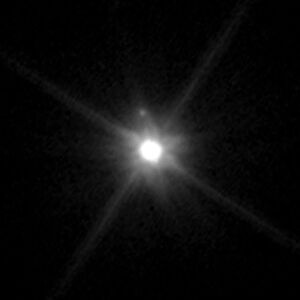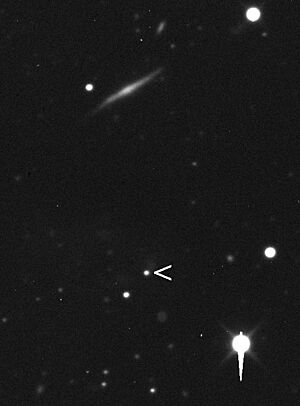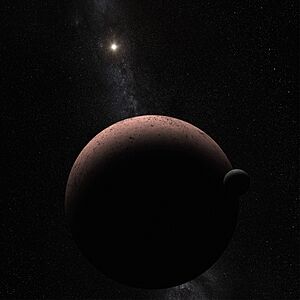Makemake facts for kids

Low-resolution image of Makemake and its unnamed moon S/2015 (136472) 1 by the Hubble Space Telescope, April 2015
|
|
| Discovery | |
|---|---|
| Discovered by |
|
| Discovery date | March 31, 2005 |
| Designations | |
| MPC designation | (136472) Makemake |
| Pronunciation | or |
|
Named after
|
Makemake |
| 2005 FY9 | |
|
|
| Adjectives | Makemakean |
| Orbital characteristics | |
| Epoch May 31, 2020 (JD 2458900.5) |
|
| Earliest precovery date | January 29, 1955 |
| Aphelion | 52.756 AU (7.8922 Tm) |
| Perihelion | 38.104 AU (5.7003 Tm) |
| 45.430 AU (6.7962 Tm) | |
| Eccentricity | 0.16126 |
| 306.21 yr (111,845 d) | |
|
Average orbital speed
|
4.419 km/s |
| 165.514° | |
| Inclination | 28.9835° |
| 79.620° | |
| 17 November 2186 | |
| 294.834° | |
| Known satellites | 1 (S/2015 (136472) 1) |
| Physical characteristics | |
| Dimensions |
(1434+48
−18) × projected (1420+18 −24 km) |
|
Mean radius
|
|
| Flattening | 0.0098 |
| 6.42×106 km2 | |
| Volume | 1.53×109 km3 |
| Mass | ≈ 3.1×1021 kg |
|
Mean density
|
|
|
Equatorial surface gravity
|
< 0.58 m/s2 |
|
Equatorial escape velocity
|
< 0.91 km/s |
|
Sidereal rotation period
|
22.8266±0.0001 h |
| Temperature |
|
| B−V=0.83, V−R=0.5 | |
| 17.0 (opposition) | |
|
|
Makemake is a fascinating dwarf planet that orbits far beyond Neptune in our Solar System. It's one of the largest and brightest objects in the Kuiper Belt. A team of astronomers led by Michael E. Brown first spotted Makemake on March 31, 2005. Its discovery was officially announced a few months later, on July 29, 2005.
Contents
Discovering Makemake
Makemake was found on March 31, 2005, by a team at the Palomar Observatory. The team was led by Michael E. Brown. They announced their discovery to the public on July 29, 2005.
Makemake is the second brightest trans-Neptunian object (TNO) we can see from Earth. Only Pluto is brighter. TNOs are objects that orbit the Sun farther away than Neptune.
Naming the Dwarf Planet
When Makemake was first found, it had a temporary name: 2005 FY9. Later, it was given the official minor-planet number 136472.
Before its official name, the discovery team had a secret nickname for it: "Easterbunny". This was because they found it shortly after Easter.
In July 2008, the dwarf planet was officially named Makemake. It was named after Makemake, a creator god from the Rapa Nui mythology of Easter Island. This name helped keep its connection to Easter.
Makemake's Orbit and Classification
As of April 2019, Makemake was about 52.5 AU (7.85 billion km) away from the Sun. This is almost as far as it gets in its orbit. Makemake's path around the Sun is quite similar to that of another dwarf planet, Haumea.
Its orbit is highly tilted, or inclined, at 29 degrees. It also has a moderate eccentricity of about 0.16. This means its orbit is not a perfect circle.
Makemake takes about 306 years to orbit the Sun once. This is longer than Pluto's 248 years and Haumea's 283 years. Makemake will reach its farthest point from the Sun, called aphelion, in the year 2033.
Makemake is known as a classical Kuiper belt object (KBO). This means its orbit is far enough from Neptune that it stays stable. It has been in this stable orbit for billions of years.
Brightness, Size, and Rotation

Makemake is currently the second brightest object in the Kuiper belt that we can see. Only Pluto is brighter. It is bright enough that you might be able to see it with a powerful amateur telescope.
Scientists have measured Makemake's size. Its dimensions are roughly (1434+48
−18) × (1420+18
−24 km). This makes it a large object, but slightly smaller than Pluto.
Makemake spins slowly. It takes about 22.83 hours to complete one rotation. This is a relatively long rotation period for a dwarf planet. Its moon might be slowing down its spin over time.
Makemake's Surface and Composition
Like Pluto, Makemake looks red when we observe it in visible light. It appears much redder than the surface of another dwarf planet, Eris.
Scientists have studied the light reflecting off Makemake's surface. This spectral analysis shows that large amounts of methane ice are present. These methane grains are at least one centimeter in size.
There might also be large amounts of ethane and tholins on its surface. Smaller amounts of ethylene, acetylene, and heavier alkanes like propane could also be there. These chemicals are likely made when sunlight breaks down methane. The tholins are probably what give Makemake its reddish color.
Makemake's surface is not the same everywhere. Most of it is covered in nitrogen and methane ices. However, there are small, dark patches. These dark areas reflect only 2 to 12% of the light. They make up about 3 to 7% of Makemake's total surface.
Makemake's Atmosphere
Makemake does not have a thick atmosphere right now. But the presence of methane and possibly nitrogen on its surface suggests something interesting. Makemake might have a temporary atmosphere when it gets closer to the Sun.
This temporary atmosphere would be similar to Pluto's. If nitrogen is present, it would be the main gas in this atmosphere.
Interesting Facts About Makemake
- Makemake was the fourth dwarf planet to be officially recognized. Even though it's quite bright, it was discovered later than many fainter objects in the Kuiper Belt.
- It has a very shiny surface, meaning it reflects a lot of sunlight.
- Makemake has one known moon, named S/2015 (136472) 1. Its nickname is MK2.
- It's incredibly cold on Makemake, with an average temperature of about 40 K (−230 °C). This means its surface is covered in ices like methane, ethane, and possibly nitrogen.
- Some research suggests that Eris, Pluto, and Makemake might have active oceans hidden beneath their icy surfaces.
- Scientists have calculated that a spacecraft could fly by Makemake in just over 16 years. This would involve using Jupiter's gravity assist to speed up the probe.
- Makemake even has its own symbol in Unicode, U+1F77C. It's mostly used by astrologers, but NASA has also used it.
Images for kids
-
Orbits of Makemake (blue) and Haumea (green), compared to Pluto's orbit (red). The closest (perihelia) and farthest (aphelia) points are marked with dates. The spheres show their positions in April 2006, along with their relative sizes and colors.
-
Makemake's orbit outside of Neptune is similar to Haumea's. The positions are as of January 1, 2018.
-
Makemake, shown with red bars, as seen by the New Horizons spacecraft in October 2007.
See also
 In Spanish: Makemake (planeta enano) para niños
In Spanish: Makemake (planeta enano) para niños
- Astronomical naming conventions
- Clearing the neighbourhood
- International Astronomical Union
- Planets beyond Neptune
- List of Solar System objects most distant from the Sun
- Ocean worlds
- Extraterrestrial liquid water






